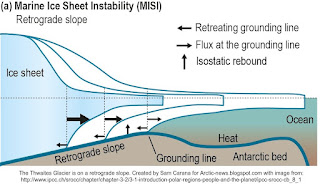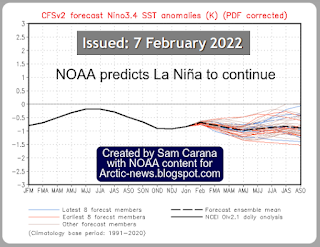by Malcolm Light
~ Wake represents the last chance for humanity to “Wake Up” to the extreme global extinction nightmare facing us; a Wake is also a Celtic “Death Watch” on our Planet Earth’s near term demise. ~
Above image shows the exponential increase of the Mean Global Atmospheric Temperature Anomaly in Degrees Celsius (Light 2021, Carana 2022, 2021; Carter, 2022) and the relative increase in Volume of Heat Transport and Temperature of the Gulf Stream–Svalbard Current into the Arctic Ocean (Smedsrud et al., 2021; Carter 2022).
The Volume of Gulf Stream Heat Transport has increased by 30% in the last 100 years (Smedsrud et al., 2021) and is estimated to be some 33.6% larger by 2030.
The Gulf Stream Temperature–Heat Transport Volume Trend intersects the Mean Global Atmospheric Temperature Anomaly Trend at 2030 with an equal and combined Arctic Atmospheric and Ocean Temperature of 11.7°C.
By this time the sub-sea Arctic shelf edge methane hydrates will be exponentially destabilizing, releasing vast volumes of methane gas into the Arctic Ocean, and this will convert the sea into a ‘Methane Bubble Foam’, vastly increasing the rate of evaporation of Arctic Ocean water.
By the Northern Summer of 2035, the Arctic Ocean and Mean Global Atmospheric Temperature Anomaly will together have reached 107.5°C and will pass 117.4°C by the Northern Summer of 2036.
After 2035, the loss of the Planet's ocean water will occur at an exponential rate, as the Ocean and Mean Global Atmospheric Temperature Anomalies rise in unison and convert Earth into a high temperature, uninhabitable planet like Venus.
It is completely self-evident that if the Gulf Stream heat transport to the Arctic Ocean is not immediately stopped, it will cause a Catastrophic Arctic Atmospheric Global Extinction event starting in 2 to 5 years culminating around 2030 (8 Years hence) (Light 2021; Carana 2022, 2021; Carter 2022).
Because of the very short time now left to the start of the Catastrophic Global Extinction Event, the Gulf Stream heat transport to the Arctic Ocean must be stopped.
The animation on the right shows that, on February 2, 2022, sea surface temperatures off the coast of North America were as much as 11.2°C higher than 1981-2011 (at green circle).
Present data indicates that the Mean Global Atmospheric Temperature Anomaly will have reached 5°C in the Summer of 2024 when massive Global extinction will begin in earnest. Therefore the latest date for effective action is the summer of 2023.
References
• Terrifying Arctic Methane Levels - by Sam Carana (2022)
https://arctic-news.blogspot.com/2021/12/terrifying-arctic-methane-levels.html
• Terrifying Arctic greenhouse gas levels continue - by Sam Carana (2022)
https://arctic-news.blogspot.com/2022/01/terrifying-arctic-greenhouse-gas-levels-continue.html
• Will COP26 in Glasgow deliver? - by Sam Carana (2021)
• Climate change: Satellites map huge methane plumes from oil and gas (BBC, 2022)
• Global assessment of oil and gas methane ultra-emitters - by Thomas Lauvaux et al. (2022)
• Nordic Seas Heat Loss, Atlantic Inflow, and Arctic Sea Ice Cover Over the Last Century - by Lars Smedsrud et al. (2021)
https://agupubs.onlinelibrary.wiley.com/doi/10.1029/2020RG000725
• The Gulf Stream has increased steadily over the last century - by University of Bergen (News Release associated with above study, 2022)
https://www.uib.no/en/climateenergy/150992/gulf-stream-has-increased-steadily-over-last-century
• Carter, Peter; 2022.
The 2021 Temperature Increase (1.1°C to 1.2°C) makes the Past Seven Years the Warmest on Record. Note Rapid Surface Heating of North America from Copernicus.
• Carter, Peter; 11 January 2022.
Arctic Sea Surface Temperature is Increasing at a Rate Far Above the Very Worst Case.
• Carter, Peter; 5 January 2022.
Through 2021 Global Warming Atmospheric Greenhouse Gases have the Planet Headed to Catastrophic Heating.
• Hampton, Steve 2021.
Modern climate change is 10x faster than historic global warming mass extinction events
• Light M.P.R., 2021.
Planetary Extinction due to Arctic Atmospheric Methane Veil
• Light M.P.R., 2015.
• Light M.P.R., 2012.
Global extinction within one human lifetime as a result of a spreading atmospheric methane heatwave and surface firestorm
https://arctic-news.blogspot.com/p/global-extinction-within-one-human.html
• Light M.P.R., 2012. Edited by Sam Carana.
How much time is there left to act, before methane hydrate releases will lead to human extinction?
• Light M.P.R., 2011. Edited by Sam Carana.
Use of beamed interfering radio frequency transmissions to decompose Arctic atmospheric methane clouds.
• Light M.P.R., 2011.
Stratospheric methane global warming veil
• Light M.P.R. and Solana C., 2002.
Arctic Methane Hydrates: A Potential Greenhouse Gas Hazard
• Light M.P.R. and Solana C., 2002.
Arctic methane hydrates - Mapping a potential greenhouse gas hazard. Abstract and Poster, EGS, Nice. In: Light, M.P.R. and Carana, S., 2011. Methane linked to Seismic Activity in the Arctic
• Light M.P.R. and Posey, H.H., 1992.
Chapter 10 Diagenesis and its Relation to Mineralization and Hydrocarbon Reservoir Development: Gulf Coast and North sea Basins
• Light M.P.R., Posey, H.H., Kyle, J.R., and Price P.E., 1987.
Integrated hydrothermal model for the Texas Gulf Coast Basin; origins of geopressured brines and lead-zinc, uranium, hydrocarbon, and cap rock deposits
• Light M.P.R., Posey, H.H., Kyle, J.R., and Price P.E., 1987.
Model for the origins of geopressured brines, hydrocarbons, cap rocks and metallic mineral deposits: Gulf Coast, U.S.A.. In: Lerch, Ian, and O'Brien, J.J., Dynamical geology of salt and related structures: Orlando, Florida, Academic Press, pp. 787-830
• Light M.P.R., 1985.
Structure, facies, continuity and internal properties of the Frio "A" sandstone, N.E. Hitchcock Field, Galveston County, Texas. In: Dorfman, M.H. and Morton, R.A. eds., Geopressured-Geothermal Energy, Proceedings of the Sixth U.S. Gulf Coast Geopressured-Geothermal Energy Conference: Pergamon, p. 229 - 238.



























